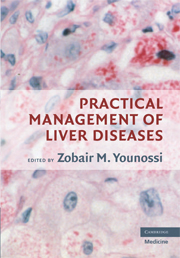Book contents
- Frontmatter
- Contents
- Preface
- Contributors
- 1 Acute Viral Hepatitis
- 2 Chronic Hepatitis B and D
- 3 Chronic Hepatitis C
- 4 HIV and Viral Hepatitis
- 5 Nonalcoholic Fatty Liver Disease
- 6 Alcoholic Liver Disease
- 7 Genetic Hemochromatosis and Iron Overload
- 8 Wilson's Disease
- 9 Alpha-1 Antitrypsin Deficiency and the Liver
- 10 Autoimmune Liver Disease
- 11 Drug-Induced Liver Disease (DILI)
- 12 Benign and Malignant Tumors of the Liver
- 13 Complications of Cirrhosis
- 14 Liver Transplantation
- 15 Novel Technologies in Studying Chronic Liver Disease
- Index
- References
12 - Benign and Malignant Tumors of the Liver
Published online by Cambridge University Press: 08 August 2009
- Frontmatter
- Contents
- Preface
- Contributors
- 1 Acute Viral Hepatitis
- 2 Chronic Hepatitis B and D
- 3 Chronic Hepatitis C
- 4 HIV and Viral Hepatitis
- 5 Nonalcoholic Fatty Liver Disease
- 6 Alcoholic Liver Disease
- 7 Genetic Hemochromatosis and Iron Overload
- 8 Wilson's Disease
- 9 Alpha-1 Antitrypsin Deficiency and the Liver
- 10 Autoimmune Liver Disease
- 11 Drug-Induced Liver Disease (DILI)
- 12 Benign and Malignant Tumors of the Liver
- 13 Complications of Cirrhosis
- 14 Liver Transplantation
- 15 Novel Technologies in Studying Chronic Liver Disease
- Index
- References
Summary
BACKGROUND
There are a large number of tumors that may grow in the liver. Most are rare, and do not merit more than a passing mention. This discussion will therefore be limited to the three benign tumors or tumor-like lesions, hemangioma, focal nodular hyperplasia, and hepatic adenoma, and to the two most common malignant tumors of the liver, hepatocellular carcinoma (HCC) and intrahepatic cholangiocarcinoma (CC). These five entities account for the vast majority of nodular lesions found on radiological examination of the liver.
HEMANGIOMA
Hemangioma is the most common liver tumor. It is found in up to 20% of autopsy series. Hemangiomas tend to occur more frequently in women than men. They may be single or multiple and may vary in size from a few millimeters to 10 cm or more, although most are smaller than 5 cm in diameter. They consist of vascular channels lined by a single endothelial layer, supported by fibrous tissue. The vascular spaces may contain thrombi that may calcify. In some hemangiomas, the calcified thrombus might be large enough to be seen radiologically. Hemangioma may be associated with focal nodular hyperplasia.
Hemangioma is a benign lesion, and never develops malignancy. Whether the lesion is hormone sensitive is controversial. There are reports of enlargement of hemangiomas with pregnancy or exogenous estrogen administration. However, hemangiomas may enlarge in the absence of these stimuli.
- Type
- Chapter
- Information
- Practical Management of Liver Diseases , pp. 195 - 214Publisher: Cambridge University PressPrint publication year: 2008



